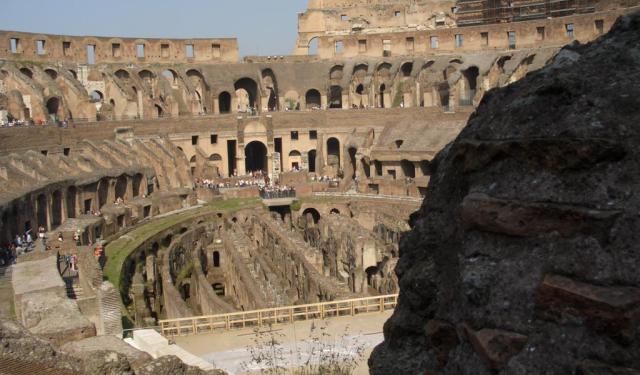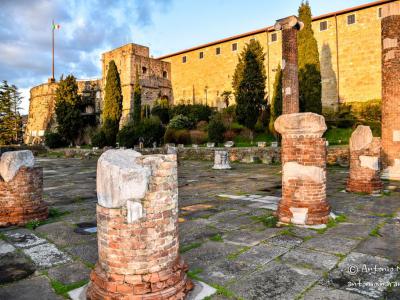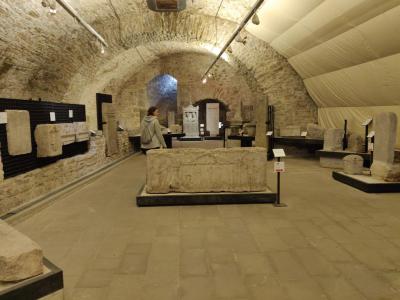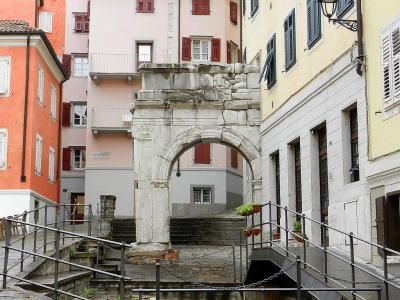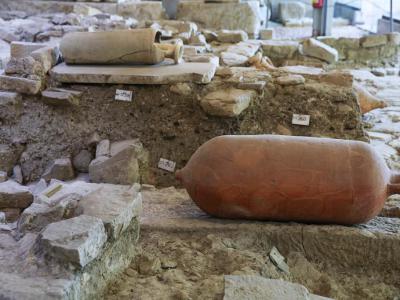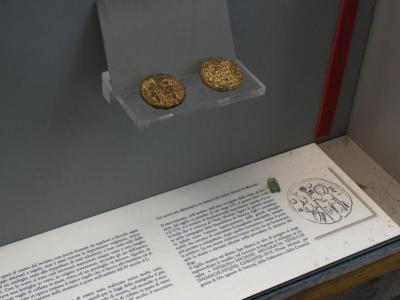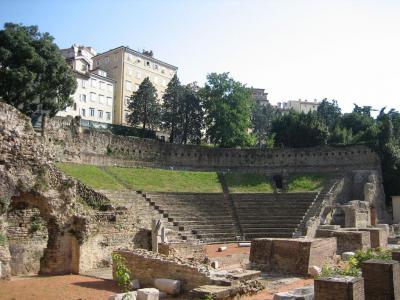Trieste's Ancient Roman Sites Walking Tour (Self Guided), Trieste
The Roman remains on Trieste extend along the northwestern slope of San Giusto Hill, overlooking the Gulf of Trieste. Wharves of sandstone slabs dating from the 1st century AD were found by the Roman Theatre. The city walls, ordered by Augustus, were converted to use as terraces.
The Propylaeum of the 1st century AD was the gateway to the sacred area of the Capitoline Temple. There are two colonnaded structures flanking a staircase and leading to a tunnel to the Lapidary Garden (Orto Lapidario). The civil Basilica on the left of the Propylaeum had three naves.
The Tergestino Lapidary in the 16th century Lalio Bastion of the San Giusto Castle houses monuments from the Roman Basilica, Forum, and Propylaeum. Shown are religious items dedicated to Jove, Cybele, Silvanus, Hercules, and Minerva.
The Roman Theatre, city walls, and the necropolis yielded altars, steles, urns, and sarcophagi with names. One room has mosaics from a 1st-century BC villa. There are items from the 6th century AD.
The Donata Antiquarium is attached to Donata Tower. Exhibits here were taken from the Roman Theatre. Behind the Theatre were a residential area and a cemetery. The theatre stone seats could hold 3,500 people. The stage was made of wood. Doors, columns, and sculptures taken from the Theatre are on exhibit at the Tergestino Lapidary in the San Giusto Castle.
The Richard's Arch (Arco Ricardo) in the Piazza Barbacan dates from the 1st century AD. The arch is simple and solid, decorated with pilasters and vegetable motifs. The Antiquarium in Seminary Street (Antiquarium via del Seminario) holds a long portion of the old city walls. The walls were made with two-facing sandstone blocks filled with rubble and lime.
An archeological zone in an ancient residential section holding fine mosaics and frescoes is reserved for further excavation. There's more to come.
The Propylaeum of the 1st century AD was the gateway to the sacred area of the Capitoline Temple. There are two colonnaded structures flanking a staircase and leading to a tunnel to the Lapidary Garden (Orto Lapidario). The civil Basilica on the left of the Propylaeum had three naves.
The Tergestino Lapidary in the 16th century Lalio Bastion of the San Giusto Castle houses monuments from the Roman Basilica, Forum, and Propylaeum. Shown are religious items dedicated to Jove, Cybele, Silvanus, Hercules, and Minerva.
The Roman Theatre, city walls, and the necropolis yielded altars, steles, urns, and sarcophagi with names. One room has mosaics from a 1st-century BC villa. There are items from the 6th century AD.
The Donata Antiquarium is attached to Donata Tower. Exhibits here were taken from the Roman Theatre. Behind the Theatre were a residential area and a cemetery. The theatre stone seats could hold 3,500 people. The stage was made of wood. Doors, columns, and sculptures taken from the Theatre are on exhibit at the Tergestino Lapidary in the San Giusto Castle.
The Richard's Arch (Arco Ricardo) in the Piazza Barbacan dates from the 1st century AD. The arch is simple and solid, decorated with pilasters and vegetable motifs. The Antiquarium in Seminary Street (Antiquarium via del Seminario) holds a long portion of the old city walls. The walls were made with two-facing sandstone blocks filled with rubble and lime.
An archeological zone in an ancient residential section holding fine mosaics and frescoes is reserved for further excavation. There's more to come.
How it works: Download the app "GPSmyCity: Walks in 1K+ Cities" from Apple App Store or Google Play Store to your mobile phone or tablet. The app turns your mobile device into a personal tour guide and its built-in GPS navigation functions guide you from one tour stop to next. The app works offline, so no data plan is needed when traveling abroad.
Trieste's Ancient Roman Sites Walking Tour Map
Guide Name: Trieste's Ancient Roman Sites Walking Tour
Guide Location: Italy » Trieste (See other walking tours in Trieste)
Guide Type: Self-guided Walking Tour (Sightseeing)
# of Attractions: 6
Tour Duration: 1 Hour(s)
Travel Distance: 0.9 Km or 0.6 Miles
Author: DanaOffice
Sight(s) Featured in This Guide:
Guide Location: Italy » Trieste (See other walking tours in Trieste)
Guide Type: Self-guided Walking Tour (Sightseeing)
# of Attractions: 6
Tour Duration: 1 Hour(s)
Travel Distance: 0.9 Km or 0.6 Miles
Author: DanaOffice
Sight(s) Featured in This Guide:
- Propylaeum and Roman Basilica
- Lapidario Tergestino (Tergestino Lapidary)
- Arco di Riccardo (Richard's Arch)
- Antiquarium di via del Seminario (Antiquarium in the Seminary Street)
- Antiquarium di via Donota (Antiquarium in Donota Street)
- Teatro Romano di Trieste (Roman Theatre of Trieste)
1) Propylaeum and Roman Basilica
The word "propylaeum" is derived from the old Greek word "propylaion," meaning literally "gateway to higher culture." In Ancient Greece and Rome, a propylaeum would usually take the form of a portico supported by columns inside and outside the actual gateway.
In pre-Christian Rome, basilicas were mostly used as public buildings. They served as law courts, financial centers, drill halls, and reception centers. Basilicas usually had apses, a semi-circular shape off the short wall of the building. The law court would be in the apse. The rest of the basilica was an audience hall.
From these forms evolved the early Christian basilicas, often keeping some elements of propylaeum. The ancient Roman buildings of Trieste are concentrated on top of San Giusto Hill. The Catholic Cathedral of Trieste was built in 1320 on the site of a 6th-century Roman Propylaeum. The remains are absorbed in the bell towers of the cathedral.
The old stairway of the propylaeum is still visible. The lapidary garden of archeologist Domenico Rossetti dates from the 19th century. There are epigraphs, monuments, and sculptures of Roman and Medieval times.
Excavations of the early 20th century uncovered bits of the old civil basilica. It had three naves. Close to the basilica is what remains of the Forum of Roman Trieste.
In pre-Christian Rome, basilicas were mostly used as public buildings. They served as law courts, financial centers, drill halls, and reception centers. Basilicas usually had apses, a semi-circular shape off the short wall of the building. The law court would be in the apse. The rest of the basilica was an audience hall.
From these forms evolved the early Christian basilicas, often keeping some elements of propylaeum. The ancient Roman buildings of Trieste are concentrated on top of San Giusto Hill. The Catholic Cathedral of Trieste was built in 1320 on the site of a 6th-century Roman Propylaeum. The remains are absorbed in the bell towers of the cathedral.
The old stairway of the propylaeum is still visible. The lapidary garden of archeologist Domenico Rossetti dates from the 19th century. There are epigraphs, monuments, and sculptures of Roman and Medieval times.
Excavations of the early 20th century uncovered bits of the old civil basilica. It had three naves. Close to the basilica is what remains of the Forum of Roman Trieste.
2) Lapidario Tergestino (Tergestino Lapidary)
The Trieste collection of antique stones, the Tergestino Lapidary, is maintained in the San Giusto Castle compound in the basement of the Lalio Bastion. The lapidary is, in effect, a memory bank of ancient Trieste.
The exposition has 130 massive stones from the capitol, sacred buildings, the theatre, and the necropolis. Room A holds the more notable honorary stones. There are plaques from the city gates on the construction of the walls, towers, and the equestrian statue of Lucius Fabius Severus, a senator of Rome.
Moving along to Room B, one finds imperial writings and records of instructions for the erection of public city buildings. Alongside are materials taken from the civil Basilica, which archeological remains are still visible on the open square at the foot of the castle.
Room C has sepulchral monuments divided by types, including stele, mounted figures, urns, and sarcophagi in memory of the ancient deceased. Descending in Room D, one gets to examine 1st-century mosaics taken from the luxurious Villa Marittima uncovered along the coast in the Barcola section of Trieste.
During the excavation of the Roman Theatre, a series of statues were uncovered representing Venus, Bacchus, Apollo, Minerva, and the cult of Hygieia (goddess of health) and Aesculapius (god of medicine). The Capitoline Temple yielded a pyramidal spire with sides showing depictions of the Capitoline Triad of Jupiter, Juno, and Minerva.
The exposition has 130 massive stones from the capitol, sacred buildings, the theatre, and the necropolis. Room A holds the more notable honorary stones. There are plaques from the city gates on the construction of the walls, towers, and the equestrian statue of Lucius Fabius Severus, a senator of Rome.
Moving along to Room B, one finds imperial writings and records of instructions for the erection of public city buildings. Alongside are materials taken from the civil Basilica, which archeological remains are still visible on the open square at the foot of the castle.
Room C has sepulchral monuments divided by types, including stele, mounted figures, urns, and sarcophagi in memory of the ancient deceased. Descending in Room D, one gets to examine 1st-century mosaics taken from the luxurious Villa Marittima uncovered along the coast in the Barcola section of Trieste.
During the excavation of the Roman Theatre, a series of statues were uncovered representing Venus, Bacchus, Apollo, Minerva, and the cult of Hygieia (goddess of health) and Aesculapius (god of medicine). The Capitoline Temple yielded a pyramidal spire with sides showing depictions of the Capitoline Triad of Jupiter, Juno, and Minerva.
3) Arco di Riccardo (Richard's Arch)
The Old City (La Città Vecchia) section of Trieste is a maze of alleys and byways rich with the breath of time. Three of these meandering alleys debouch in the small, stone-paved Barbacan Square (Piazza Barbacan). The little square is lined with old, multi-colored buildings. Sticking out from the side of one of them is the ancient Richard's Arch (Arco di Riccardo).
The Arch is 23 feet tall and 17 feet wide. It was once part of the city wall, long since demolished. The date of origin is uncertain, though most agree it might be sometime in the first century BC. There is some ornamentation, possibly added in the first century AD.
It is thought that the structure was named for Richard I of England. Richard is said to have been a captive in Trieste while returning from the Holy Land. A more likely theory is the use of the word "cardo," meaning the main north-south road of Roman settlements. Or, it is from "Ricario Arch," Ricario was a neighboring courthouse.
The Richard's Arch was usually visible throughout the Middle Ages and sometimes incorporated into buildings. The western side was excavated in 1913. The eastern part remains snuggled into a modern building.
The Arch is 23 feet tall and 17 feet wide. It was once part of the city wall, long since demolished. The date of origin is uncertain, though most agree it might be sometime in the first century BC. There is some ornamentation, possibly added in the first century AD.
It is thought that the structure was named for Richard I of England. Richard is said to have been a captive in Trieste while returning from the Holy Land. A more likely theory is the use of the word "cardo," meaning the main north-south road of Roman settlements. Or, it is from "Ricario Arch," Ricario was a neighboring courthouse.
The Richard's Arch was usually visible throughout the Middle Ages and sometimes incorporated into buildings. The western side was excavated in 1913. The eastern part remains snuggled into a modern building.
4) Antiquarium di via del Seminario (Antiquarium in the Seminary Street)
The Antiquarium is located on Seminary Street, on the hill of San Giusto. This site preserves a portion of the ancient city walls, 8 feet wide and 13 feet high. The remains are of two outer faces of sandstone filled with stone rubble and lime. At the base of the wall is a small moat for water runoff.
From the middle of the first century BC and the first century AD the city walls lost their effectiveness as defenses. They came to be used as terraces and retaining walls, supported landscaping, and held the hillside in place. The walls are said to have been built by Octavian in 33 BC before he became Augustus Caesar.
Close to the wall is a room floored with opus spicatum ("herringbone work"). Bricks are arranged in a fishbone pattern. This style was frequently seen in old Roman constructions. Pieces of amphorae (large urns) were also found here. It is thought the room was used to process oil and to house an oil press.
The Antiquarium in Seminary Street is open to visitors on Saturdays from 10 am to 12 pm.
From the middle of the first century BC and the first century AD the city walls lost their effectiveness as defenses. They came to be used as terraces and retaining walls, supported landscaping, and held the hillside in place. The walls are said to have been built by Octavian in 33 BC before he became Augustus Caesar.
Close to the wall is a room floored with opus spicatum ("herringbone work"). Bricks are arranged in a fishbone pattern. This style was frequently seen in old Roman constructions. Pieces of amphorae (large urns) were also found here. It is thought the room was used to process oil and to house an oil press.
The Antiquarium in Seminary Street is open to visitors on Saturdays from 10 am to 12 pm.
5) Antiquarium di via Donota (Antiquarium in Donota Street)
The Antiquarium is an archeological zone with a museum annex. It is located in the lower part of the hill of San Giusto, in Donata Tower, a medieval wall tower. The exhibits come from digs of the 1980s in the area of the Roman Theatre and along Donata Street. During excavations, a wealth of archeological finds were unearthed.
One construction was built on several levels on the hillside. It was located outside the Theatre and the city walls. It certainly was a residence in the first century AD. The walls have frescoes and plaster decorations. Fine dinnerware uncovered indicates the residents had wealth. By the mid-second century, the house was buried.
An enclosure built around the area was used as a cemetery. Tombs and coffins were found along with urns, large enough to hold children's bodies. One room is devoted to items found while uncovering the house (Domus), the burials, and a dwelling near the Barbacan Square and the Arch of Riccardo.
One construction was built on several levels on the hillside. It was located outside the Theatre and the city walls. It certainly was a residence in the first century AD. The walls have frescoes and plaster decorations. Fine dinnerware uncovered indicates the residents had wealth. By the mid-second century, the house was buried.
An enclosure built around the area was used as a cemetery. Tombs and coffins were found along with urns, large enough to hold children's bodies. One room is devoted to items found while uncovering the house (Domus), the burials, and a dwelling near the Barbacan Square and the Arch of Riccardo.
6) Teatro Romano di Trieste (Roman Theatre of Trieste)
Down at the base of Saint Giusto Hill, Trieste keeps shows that the Romans knew how to put on a show. The theatre, first raised in the 1st century AD and bulked up under Emperor Trajan in the 2nd, could pack in thousands-anywhere from 3,500 to 6,000 spectators. They leaned into the hillside for tiered seating, with the stage facing the sea, giving audiences drama on stage and scenery behind it. Plays, political speeches, and civic gatherings all unfolded here, making the spot a hub of Roman public life.
Eventually, though, the theatre slipped out of use and into obscurity, smothered under later buildings. By the 19th century, sharp-eyed scholars like Pietro Nobile and Attilio Tamaro were already convinced it was hiding beneath the Old Arena district. They were right-when the city reshaped itself in 1938, the theatre finally came back into daylight. Excavations exposed its stone seating, the orchestra pit, and the stage foundations, with statues and inscriptions carted off to the Civic Museum of History and Art.
Today, the theatre is wide open to wander. From the street, its semicircle of stone benches climbs the slope in quiet rhythm, still echoing with the memory of Roman voices. Lit up at night, it doubles as an open-air relic glowing between the bustle of the Unity of Italy Square and the climb toward Saint Giusto Hill. Despite all of Trieste's attractions, this one still gathers crowds regularly. Be a part of the spectacle, no ticket needed.
Eventually, though, the theatre slipped out of use and into obscurity, smothered under later buildings. By the 19th century, sharp-eyed scholars like Pietro Nobile and Attilio Tamaro were already convinced it was hiding beneath the Old Arena district. They were right-when the city reshaped itself in 1938, the theatre finally came back into daylight. Excavations exposed its stone seating, the orchestra pit, and the stage foundations, with statues and inscriptions carted off to the Civic Museum of History and Art.
Today, the theatre is wide open to wander. From the street, its semicircle of stone benches climbs the slope in quiet rhythm, still echoing with the memory of Roman voices. Lit up at night, it doubles as an open-air relic glowing between the bustle of the Unity of Italy Square and the climb toward Saint Giusto Hill. Despite all of Trieste's attractions, this one still gathers crowds regularly. Be a part of the spectacle, no ticket needed.
Walking Tours in Trieste, Italy
Create Your Own Walk in Trieste
Creating your own self-guided walk in Trieste is easy and fun. Choose the city attractions that you want to see and a walk route map will be created just for you. You can even set your hotel as the start point of the walk.
Trieste Introduction Walking Tour
Let’s drop into Trieste, a city that’s always had one foot in Central Europe and the other dipping into the Adriatic. It sits at Italy’s northeastern edge, pressed against Slovenia, where winds tear across the Karst Plateau and caves open like gateways underground. Some call it “Vienna by the Sea,” others swear it’s the “City of Coffee,” but labels never really fit. From the start,... view more
Tour Duration: 2 Hour(s)
Travel Distance: 3.7 Km or 2.3 Miles
Tour Duration: 2 Hour(s)
Travel Distance: 3.7 Km or 2.3 Miles
The Most Popular Cities
/ view all
